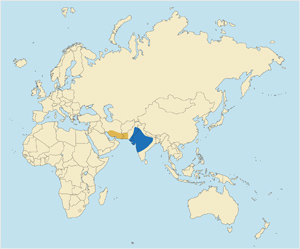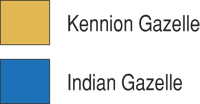Indian Gazelle or Chinkara | Online Record Book Preview
This is a preview of the Indian Gazelle or Chinkara species only.
Once you subscribe you will be able to view all the entry details for hundreds of different species, including full score sheets and photos.
Indian Gazelle or Chinkara - Species Detail |
| AKA: |
Ravine deer |
Gold: |
29 6/8" |
Gold (Bow): |
27 5/8" |
| Endangered: |
|
Silver: |
28 5/8" |
Silver (Bow): |
0" |
| Bronze: |
23" |
Bronze (Bow): |
0" |
Gazella bennetti bennetti
Gacela India, Chinkara (Sp), Indischer Gazelle (G), Gazelle de l'Inde (F). Chinkara is its Hindustani name. Inappropriately called ravine deer by many sportsmen during the colonial era.
DESCRIPTION (male) Shoulder height 23-26 inches (58-66 cm). Weight 40-60 pounds (18-27 kg). Females are about four inches (10 cm) shorter than males and considerably lighter in weight.
A graceful, elegant gazelle with a relatively long neck, legs and ears. The upperparts are a sandy reddish-brown, darkening slightly where they meet the white underparts. The chin, breast, belly and inside of legs are white. The tail is very dark brown, as are the knees. The bridge of the nose and forehead are brown, and brown stripes extend from the inner corner of the eyes to the nose. The horns (both sexes) exhibit many variations in shape, but most are quite straight and slightly divergent, with the tips curving a little forward and inward. They have 10-25 pronounced rings, and are well separated at the base in males-more so than in the Kennion gazelle. The female's horns are closer together than the male's, and thinner and straighter. Also in contrast with the Kennion gazelle, the females horns are less than half as long as the male's.
Of the three subspecies listed by Groves, the scientifically unnamed Salt Range form is the largest and grows the longest horns, but the females are relatively smaller than in other races. Its overall color has been described as a rich tobacco-brown. Horns average 10-3/4 to 12-1/4 inches (27-31 cm), with 15-5/8 inches (39.7 cm) the longest of record (Rowland Ward, 1906).
The christii race of Sindh and the Indian desert is smaller than the Salt Range race, though slightly larger than the Kennion gazelle of Baluchistan and Iran. Male horns average 9-1/2 to 11 inches (24-28 cm), with 14-3/4 inches (37.5 cm) the longest of record (Rowland Ward, 1909). Its coat is very short, with little seasonal variation, and colored a drab, pale, silvery brown.
The bennetti race in the east is the smallest Indian gazelle and slightly smaller than the Kennion gazelle. Its horns are comparable to those of christii, averaging about 9-1/2 to 10-1/2 inches (24-27 cm). Its coat is distinctly longer in winter than in summer and more brightly colored than in christii, with distinct contrasts. The upperparts are reddish-brown or tawny, as are the lower flanks, with the area in between lighter and duller.
DISTRIBUTION From the Indus River valley of Pakistan eastward through the Ganges River valley in northern India, and southward to the Deccan Plateau in southern India.
TAXONOMIC NOTES Groves lists three subspecies: an unnamed subspecies from the Salt Range east to Gwalior and south to Sira; christii, from Sindh and western Rajasthan south through Kathiawar; and bennetti, from the Ganges valley south to the Deccan Plateau. They are combined here with bennetti Sykes, 1831 having priority.
|
| Member |
Taken |
Location |
Hunting Company/Guide |
Measurer |
MOK |
Score |
OR |
MR |
The Indian Gazelle or Chinkara currently has 66 Entries listed in the SCI Record Book!
Once you subscribe you'll be able to access photos and full socre sheets for all of these entries. Plus you can filter, sort, and search through all species and entries in the SCI database. If you would like to subscribe now to have access to the entire database, please click here.
|
Return to Top
|





